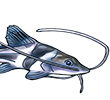Article © Julian Dignall, uploaded July 24, 2013.

Juvenile Scobinancistrus aureatus from the Rio Xingu, Brazil
Q1: Who is collecting the money?
All donations are made via a FundRazr page set-up for the project. Payments can be made globally and this route handles all the social media and interaction with donors as well as providing PayPal and credit card facilities. All donations are in US dollars. At the point of donation, the money (less a small handling fee) is automatically send from FundRazr into a PayPal account administered by me.
Q2: Who is received the money?
When the fundraising ends, I will make one transfer of the money to Mark Sabaj Perez who will be responsible for distributing amongst the research team.
Q3: What will the money be used for?
In 2013, we are aiming to raise US $11,000 (our fundraising goes up to 11)! The principal item is a laboratory grade water flow measuring device to record the rate of flow of the river at different points or depths. This will cost around $7,000. The remainder of the cash is to pay for additional travel, subsistence and communication costs to support the research team in informal interaction with the online aquarist communities via PlanetCatfish.com. Or, in short, to fund for outreach activities connecting the riverside team to the desktops and mobiles of the catfish aquarist community. Additionally, many photos and information gathered will be formally shared with the community well ahead of formal publication.
Q4: Why are you / PlanetCatfish.com doing this, what do you want to achieve?
There are really two aims I would highlight. The first is to support ichthyological research into a threatened habitat that contains fishes of significant interest to aquarists by providing financial support in return for informal access to the day-to-day activities of the research team. Hopefully this can bring the ichthyologists and aquarists closer together by giving both parties a better understanding of what makes the other tick. New species are as exciting to ichthyologists as they are to aquarists, but often for different reasons. The second aim is to more broadly test if crowdfunding (ichthyological) research projects like this can work — so it has the potential to be repeated again to further bring the research to a wider set of consumers (in this case aquarists).
Q5: What are the direct benefits to fish keepers if this project becomes fully funded and moves forward?
Specifically, it will help the ichthyologists record precise measurements of water flow in different habitats alongside the species of fishes common to those habitats. Such data will be useful not only to ichthyologists, but to aquarists trying to replicate certain conditions in their tanks. In a broader sense, the project will help provide a snapshot of the aquatic biodiversity, water chemistry and habitat conditions of the Lower Xingu River before it is altered by the completion of the Belo Monte dam complex.
Q6: What happens if donations exceed $11,000 USD?
At present, the FundRazr donations page is not configured to stop taking donations once the total has been reached. If there is a small surplus, it will just increase the total amount donated to the Project.
Q7: Will you (or any other members of the PlanetCatfish team) benefit from the donations?
Not financially, that's to say, for example, should one or more of us decide to join the expeditions / travel to Brazil then we will be paying for that out of our own pockets. Furthermore there are no plans to sell any of the information and material produced by the project for profit. Major funding for the Xingu project comes from the National Science Foundation which is ultimately supported by US tax dollars. Such funding requires that the results of the project be made freely to the public to advance understanding and appreciation of the natural world.
Q8: What is the platform for interaction with the research team?
Ahead of each expedition, there will be one or more topics created in the PlanetCatfish forum and widely publicised to allow donors to form questions. These questions will be discussed, collated and sent to Mark for response during the expedition and shortly afterwards. These can be anything from can you show me a pic of the biggest Hypancistrus you find to what they had for breakfast. The idea is to find out about the process, the activities as well as the more directly useful aquarist type questions (e.g. where zebra plecos live, what is the water temperature at the surface and where they are found). The responses will be published as articles which will remain on the site indefinitely. This is more permanent, easy to find and reference in future than forums or other social media channels.
Read The PlanetXingu Project Pt 4 - Who is Nathan Lujan?.
Back to General Articles index.




